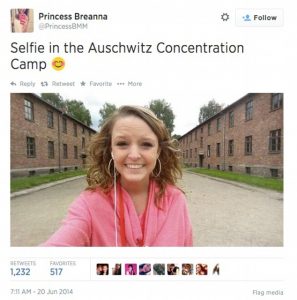by Jessica Wang
Abstract
To investigate selfies as a new form of genre arise with social media. Connect nationalism, a concept discussed in sociology, with rituals in memorial sites. Can selfie be a new way to remember and witness historical traumas?
In the research article, “Youth, trauma and memorialisation: The selfie as witnessing”, by Kate Douglas, the writer performed close readings on several self-portraits (or “selfies”) taken by young people visiting Auschwitz concentration camp, and USS Arizona Memorial. She encourages readers to adopt a new perspective on selfie, to see it as a form of self-representation, and invites scholars to join the research conversation: selfie as a new way of witnessing and responding to historical traumas.
Douglas states that, people commonly see selfie as an action of “vanity, narcissism and fakery or from insecurity and conformity”. The negative attitudes from the society against selfies, are associated with the purpose and circumstances they are usually taken. Figures 1, 2, and 3 are some selfies published on Facebook. In the public view, youths most commonly take selfies of their appearance, body, and lifestyle… Then, with one click, they are able to present themselves to the world. However, this generalization is limited and biased. Self-portraits now as a trend among the younger generation, can be a new form of autobiography or self-representation.

Figure 1

Figure 2

Figure 3
In the research titled “Classifying the narrated #selfie: genre typing human-branding activity”, Eagar and Dann describe selfies as a way of constructing “personal narratives that develop and support an individual’s human brand”. They also suggest, selfies can be characterized into genres including: autobiography, parody, propaganda, romance, self-help, travel diary and coffee-table book. Indeed, some scholar researches do reflect that selfie is a form of life narrative for the young generation to express variety of emotions and thoughts. In Douglas’s article, she discusses several controversial selfies published on social media, including one taken by a U.S. girl named Breanna Mitchell in front of Auschwitz memorial site (figure 4). Mitchell explains the photograph was to honour her father, who passed away before they were able to visit the site together. In this case, selfie could be a genre to document one’s emotions and experience.

Figure 4
In her article, Douglas also investigated the purposes of memorial sites. She suggests they are built for the “acknowledgement of communal traumas”. At memorial sites, visitors are often asked to perform certain rituals such as silently reflecting, witnessing, and remembering. They also have to obey restrictions for behaviours, and respect the people lost their lives in the traumatic event. In fact, the rituals and witnessing also inspire pride and collective conscience of nationalism among the people of the nation. Although this may vary by cultures and states, the memorial sites educate their visitors about the historical traumas, to create a sense of belonging and pride about the country. All the behaviour codes set a solemn atmosphere for a national purpose. Are selfies inappropriate for this purpose, or do they also encourage other people to resonate with the national pride?
Depending on the culture background and beliefs, people may respond and witness historical traumas in different ways. Youths could use selfies as a form of auto/biographical representation to deliver any type of message to the world, whether the messages are shallow responses or intense remembering. Through scholar discussions, we investigate the motivations behind taking selfies at different occasions, instead of generalizing or stereotyping them. With advancing technology, the society also need to evolve and adapt to new forms of communication. Self-portrait is being used by more cultures and population as life narrative. Not only the younger generations should be educated about the significant meanings of memorial sites, the society should also adapt to new trends came with technology.
References:
Eagar, Toni, and Stephen Dann. “Classifying the Narrated #selfie: Genre Typing Human-branding Activity.” European Journal of Marketing 50.9/10 (2016): 1835-857. Web.
Douglas, Kate. “Youth, trauma and memorialisation: The selfie as witnessing.” Memory Studies,
1-16, Sage, 2017, http://journals.sagepub.com/home/mss